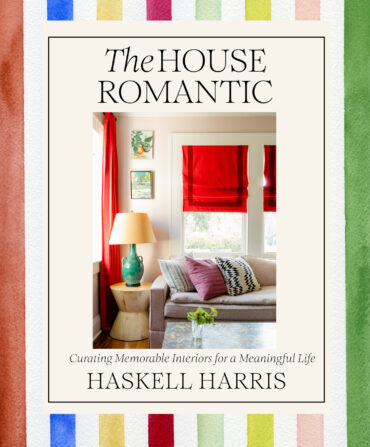Gardens
Between the Hedges with Vince Dooley
Hall of Fame football coach, athletic director… master gardener? How the University of Georgia legend found a second love on the turf around Athens

Photo: Ali Harper
Vince Dooley is telling a magnolia story.
It’s not about one of those towering evergreen magnolias that anchor many a Southern lawn. The one he’s referring to is the one he’s standing under right now—a smaller, lesser-known variety called Sayonara. After Dooley planted the tree, it declined to blossom for eighteen years. But one spring, a group from the Magnolia Society International came to visit his garden. And that was the year Sayonara decided to show off, the flowers as big as dinner plates.
As Dooley finishes the story, he glances up. It’s April, and Sayonara is supposed to be done by now, but at the end of one branch, there’s a bud with a burst of white at the crown.
“Well, that’s a surprise,” he says. “I had no idea it would bloom this late.”
When it comes to plants, Vince Dooley knows something about being a late bloomer.
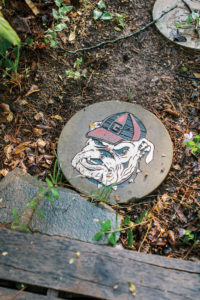
Photo: Ali Harper
A stepping stone nods to Dooley’s football past.
He spent his career as a football man. Twenty-five years as head coach at the University of Georgia, with 201 wins, six SEC titles, and one national championship (the 1980 team led by the great Herschel Walker). Twenty-four years as the Bulldogs’ athletic director, a position he kept after retiring as coach in 1988. A member of the College Football Hall of Fame. And if none of those honors impress you, give a listen to the 1975 James Brown cut “Dooley’s Junkyard Dawgs.” (They’ll hit ya / They’ll knock ya / They’ll haul right off and sock ya…) Did the Godfather of Soul ever sing about Nick Saban? No, he did not.
Inside Dooley’s Athens home—where he and his wife, Barbara, have lived since 1964—the remnants of his life in sports are everywhere. Trophies cover the end tables, portraits from his career hang on the walls, and two sets of shelves are crammed with hundreds of bulldogs—plush, metallic, ceramic, and wooden—that fans and his kids have given him over the years.
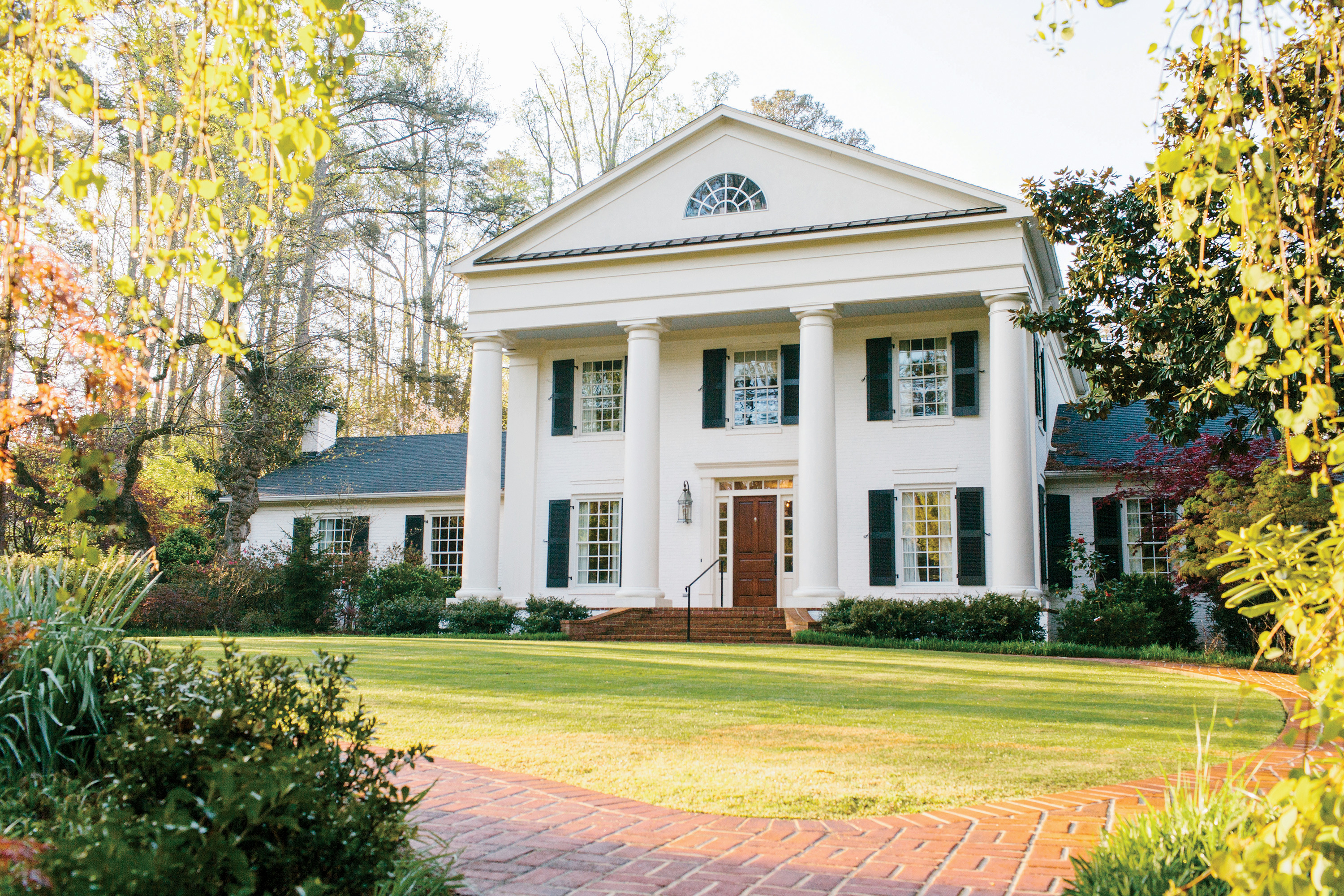
Photo: Ali Harper
The Dooley home, framed by an Amazing Grace weeping katsura tree.
These days, though, Dooley pays more attention to what’s outside.
To the surprise of everyone he knows—including himself—Vince Dooley has devoted his life to plants over the last twenty years, becoming a master gardener along the way. (That’s an official title, in fact, bestowed by the UGA Cooperative Extension office.) Now, at eighty-four, he travels the world visiting gardens and speaking at gardening
conferences. He has written a book, Vince Dooley’s Garden. He has a camellia and a hydrangea named after him.
And the showplace for all those years of work is the two and a half acres that used to be his yard. A botanical garden now stands in its place, lush and fragrant, crammed with just about every plant he can get ahold of.
There aren’t many bulldogs out here. But there is a little sign stuck in the dirt marking it as Vince’s Garden, along with a quote from another Vince, Van Gogh: If you truly love nature, you will find beauty everywhere.
By now Dooley is a veteran tour guide—garden clubs come out here by the busload. So as he walks down the mulch-covered trails, he has a story for every plant. Here’s a viburnum, the Chinese snowball, with blooms so big people think it’s a hydrangea. Here’s a resurrection fern that came with a chunk of oak tree—the fern looked dry and dead until they watered it, and sure enough, it was resurrected. Here’s a beautiful bald cypress, one of the limp-limbed weeping trees Dooley loves so much. He even named the little brook that runs through the property Weepers Creek.
Here, by the driveway, stands a spectacular Japanese maple. Dooley bought it for Barbara on their thirty-ninth anniversary. The tree was already so big he had to hire a crane to plant it. The family joke goes that when he brought Barbara out for the big reveal and told her it was her anniversary present, she started looking through the leaves for diamonds and gold.
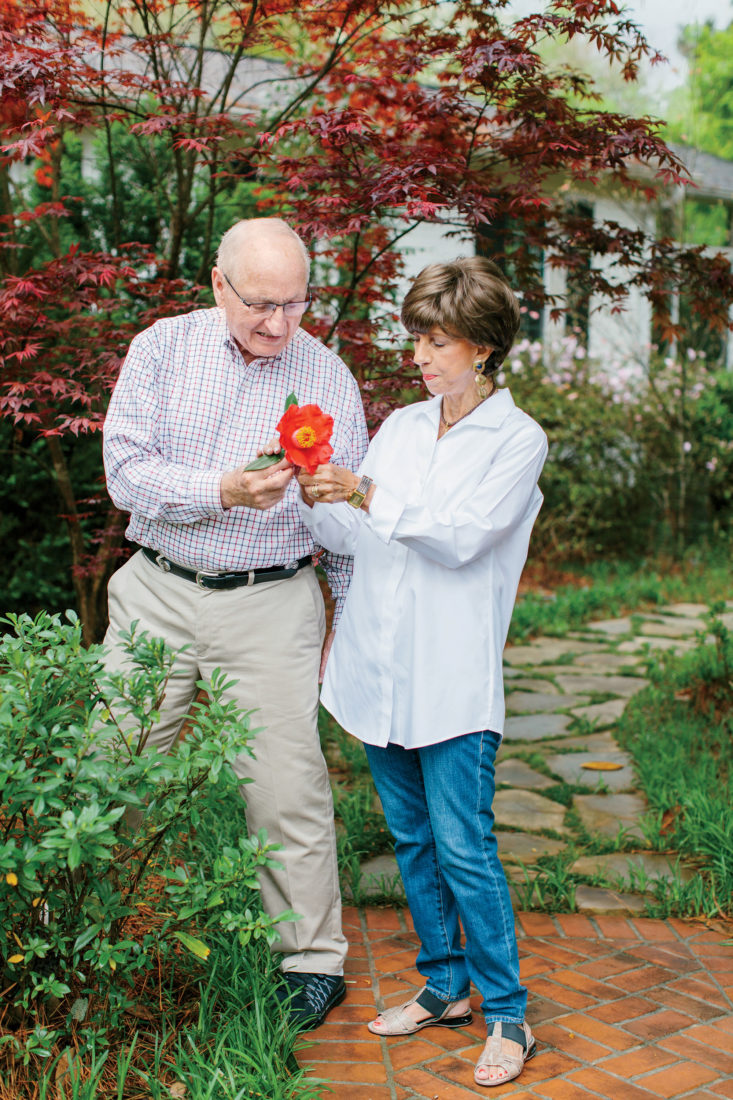
Photo: Ali Harper
Dooley and his wife, Barbara, with the bright-red camellia named after him.
The Dooleys have been married fifty-seven years now, and they have perfected their comedy routine: Barbara gives Vince grief, and Vince plays the put-upon husband. They’re talking about a gazebo Vince put in a few years ago. “He told me when we bought it, we were going to have wine there in the evenings,” she says. “You know how many times we’ve done that? Zero.”
“That’s what it’s for, and that’s the plan,” Vince says. “As soon as I get the rest of the garden built around it.”
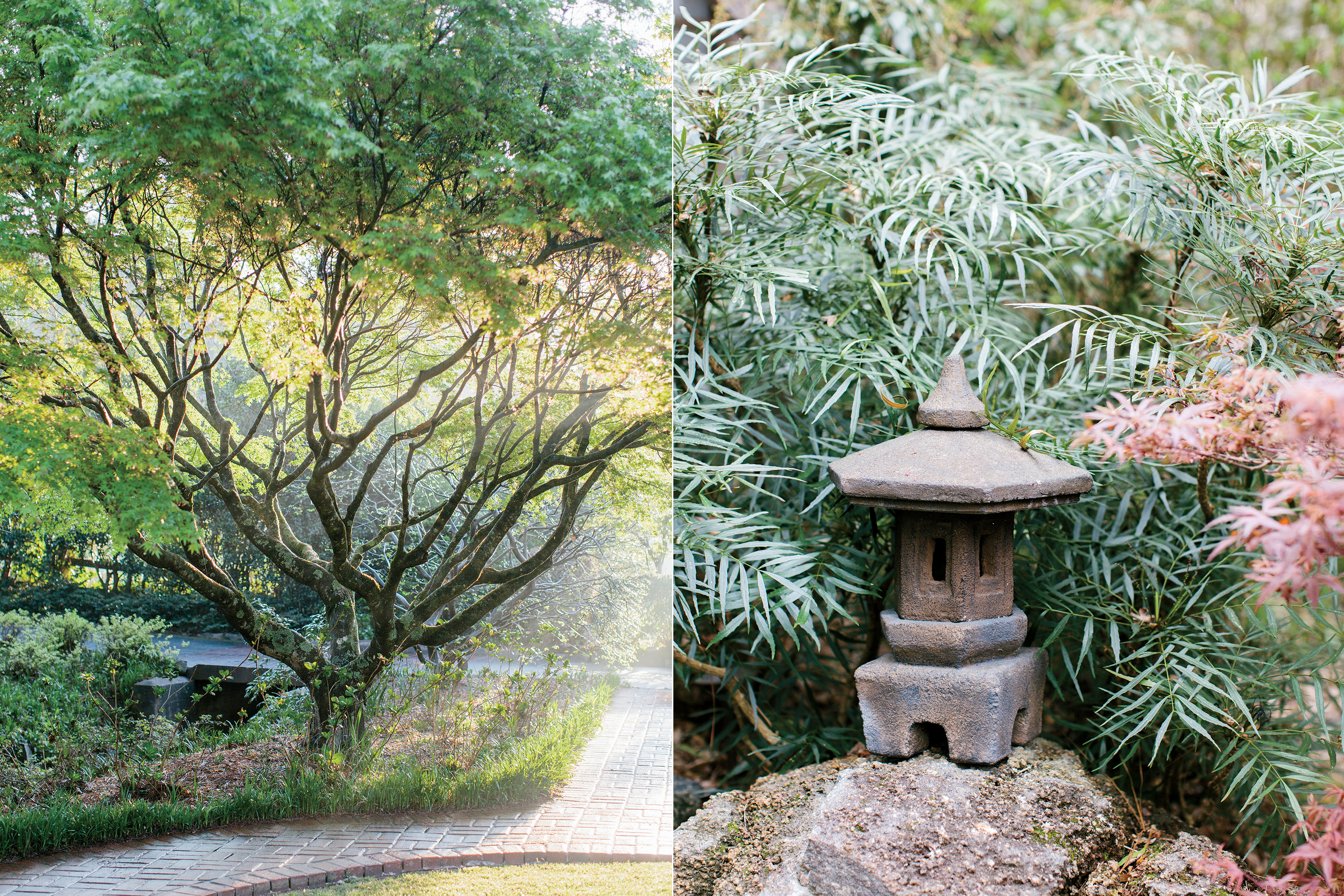
Photo: Ali Harper
From left: The Japanese maple Dooley gave Barbara on their anniversary; A Japanese lantern with a mahonia Soft Caress shrub.
None of this was the plan, exactly; horticulture is just where Dooley’s curiosity landed. He had taken university classes now and then even when he was coach—mostly history and leadership, things he could put to use on the football field. But after he retired from the gridiron, his mind wandered in all kinds of directions. He took a New Testament class, and one in art history. Then he thought about plants. He remembered using blue hydrangeas to crown the Virgin Mary statue at the Catholic school in Mobile, Alabama, where he grew up. He recalled how the trees around the practice field at UGA shimmered with color every October. But he knew nothing about most of the plants he saw.
So in 1995, he asked UGA professor Michael Dirr if he could sit in on Dirr’s class on woody landscape plants. Dooley decided to take a second seminar with Dirr, to pay better attention—the Latin names whooshed right by him the first time around. Slowly, the hook set. He kept going back to classes by Dirr and another professor, Allan Armitage. He asked questions and memorized all those Latin names and hung out with the horticulture majors, them in T-shirts and jeans, him in his athletic director’s jacket and tie.
“Coach is a great student,” Dirr says. “It’s kind of a lifelong journey of the mind for him.”
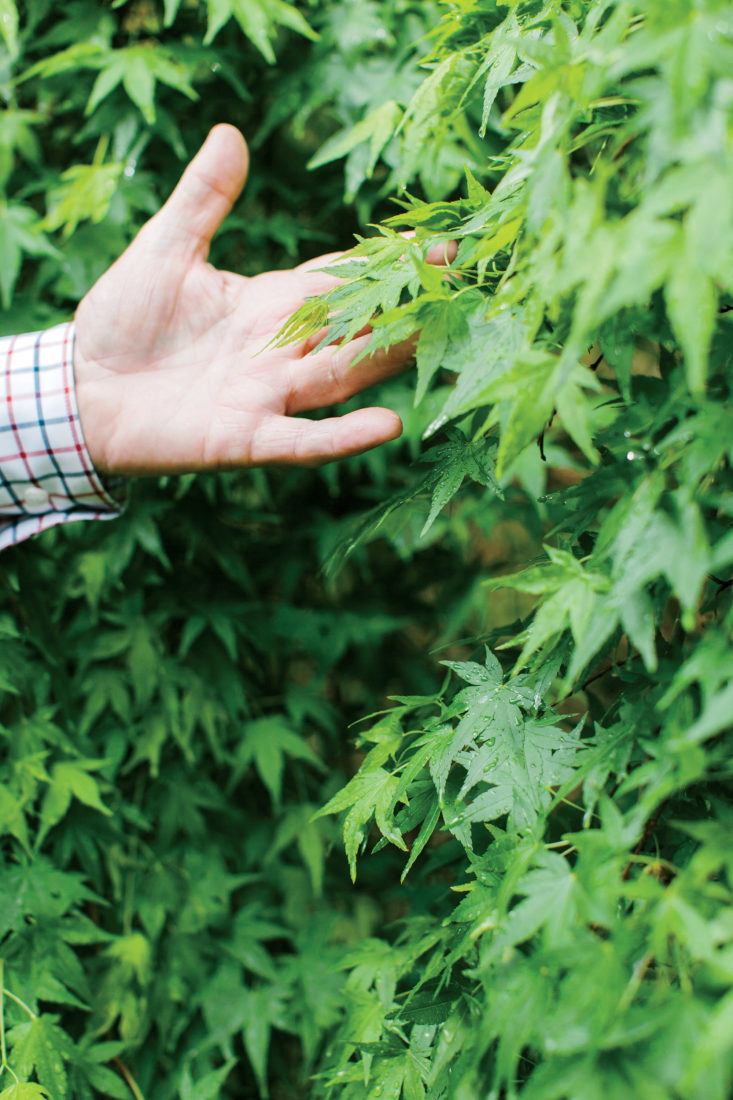
Photo: Ali Harper
Dooley inspects the overlapping leaves of a Mikawa Yatsubusa dwarf Japanese maple.
At home, Dooley started working on his plot of land. Most of the front was lawn—their kids, and then grandkids, played football out there after Georgia games on Saturdays. There were a few flowers, mostly planted by the Dooleys’ yard man, but the rest was jungle. Dooley had to hack his way through the privet and vines to clear space for a serious garden.
At first he planned with pigskin on the brain—he’d put plants in the ground in a T formation, one in the front, two in the back. As he went along, with the help of Dirr and Armitage, he figured out which layouts he liked best and the varieties that moved him. He fell in love with Japanese trees—the endless colors of Japanese maples, the waterfall limbs of the katsura. When he put in a pump out back and then decided he didn’t like the way the device looked in the garden, he built a Japanese teahouse around it.
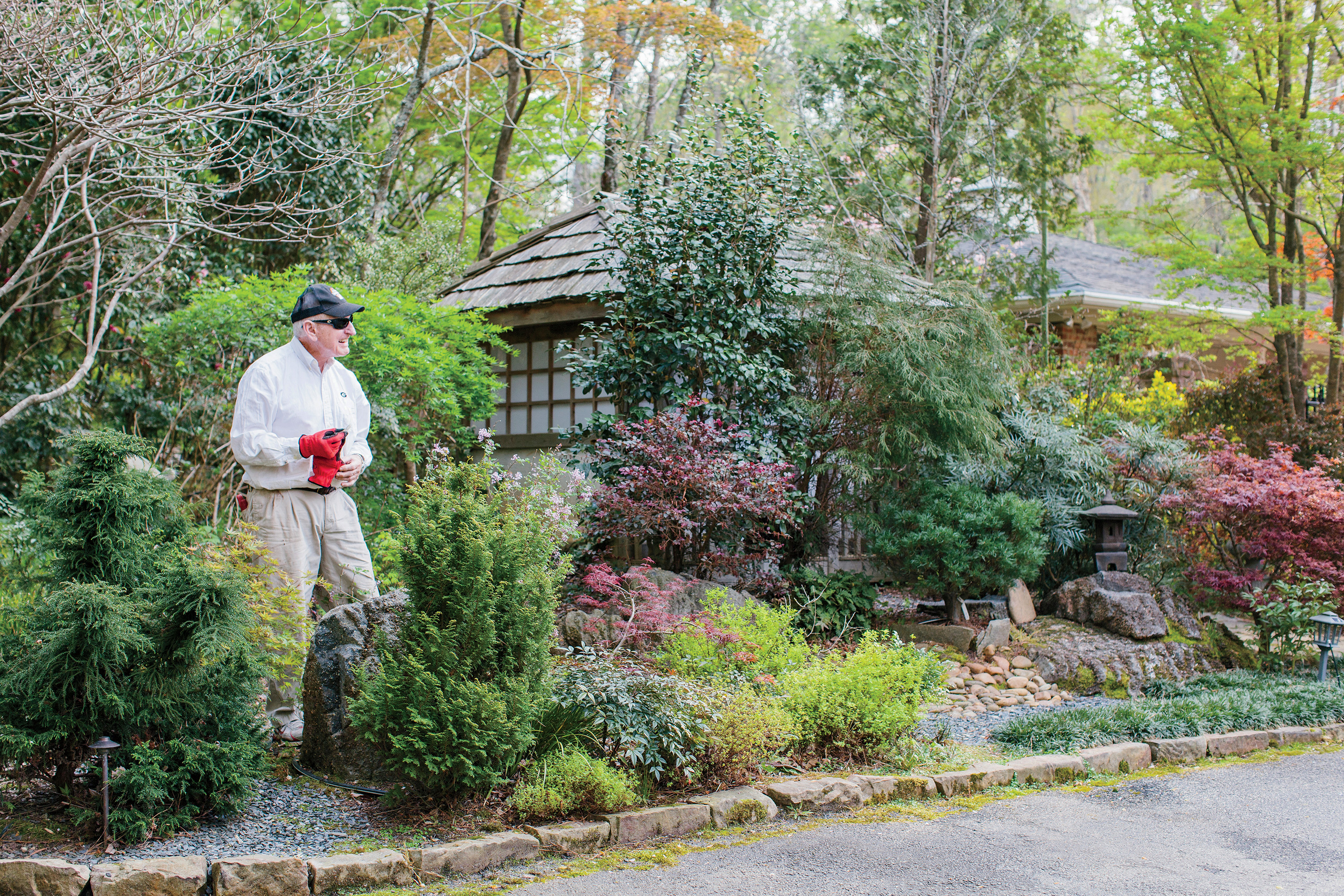
Photo: Ali Harper
The Japanese garden, with teahouse.
Just to the right of the Dooleys’ front door grows the Dooley camellia, named by the American Camellia Society, which is located in Fort Valley, Georgia, near Macon. The petals boast bright scarlet—UGA’s team colors are red and black. As Dooley tells the story, he snaps off a flower for Barbara. “This is killing his heart,” she jokes, and then smiles: “Ooh, this one is beautiful.”
The Dooley hydrangea, on the other hand, was sort of Barbara’s doing. In 1968, she bought three bigleaf hydrangeas on sale from a nursery and positioned them near the house. Years later, Dirr noticed that they kept blooming after frost killed off most other hydrangea buds. He studied the shrub, decided it was a unique variety, and named it after Dooley. They’re now sold at nurseries everywhere.
But back when he got those hydrangeas, all Dooley knew was that they were pretty. Even when he started to get serious about gardening, he was such a novice that he thought he could acquire one of every plant. He learned pretty fast that was going to be impossible. But he’ll still try to cultivate just about anything. Dirr develops hybrids to sell to nurseries, and that involves making dozens of seedlings that he narrows down to a few he likes best. He’ll take the top two of those to market and give Dooley two or three of the leftovers. Sometimes Dooley’s turn out better than the ones Dirr chose. “I’ve had to go back and get cuttings from my throwaways in his garden,” Dirr says. “He’s like a center fielder—he catches all my mistakes.”
Dooley hangs tags on most of his species, but there are still too many to keep track of. Sometimes he remembers the Latin name but not the common name; sometimes it’s the other way around. “Look, there are lilacs,” he says, bending down to touch the flowers. “I’d forgotten I planted lilacs.”
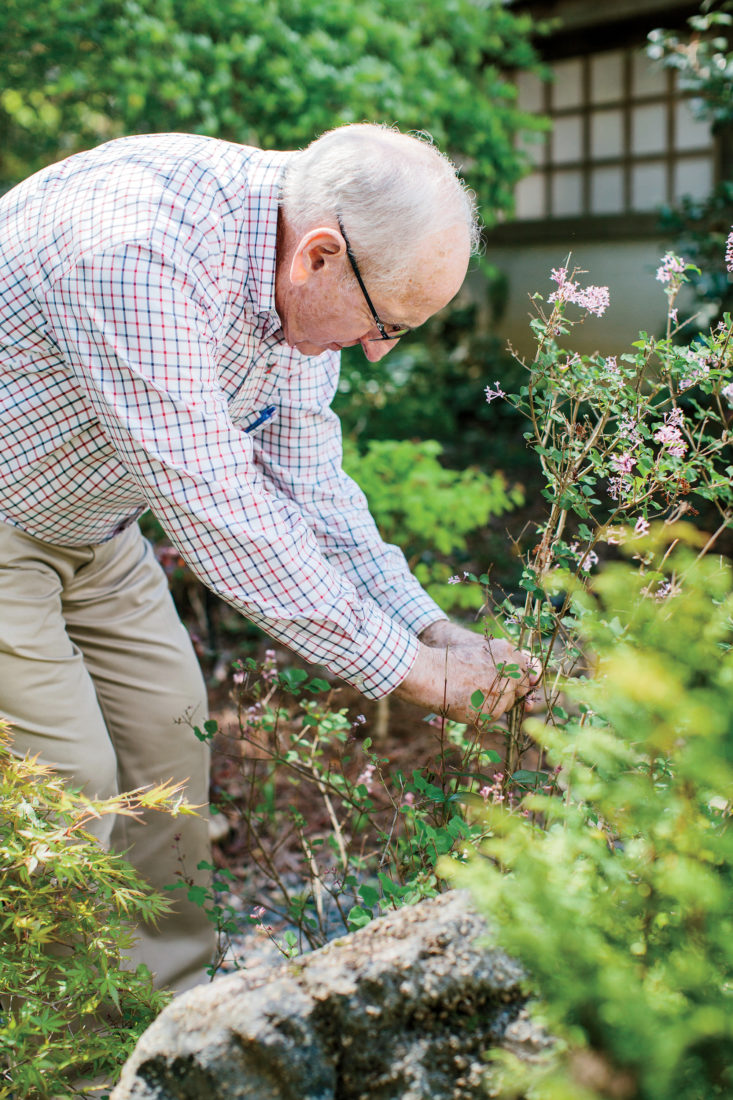
Photo: Ali Harper
Dooley stakes a Bloomerang lilac.
On this day he’s ambling through in pressed khakis and a checked shirt with a little bulldog just above the pocket. But most of the time he’s out here in work clothes, getting dirt under his fingernails. He does as much as he can himself and gets help with the rest. On one side of his patio, he keeps a small area called Ryan’s Garden in honor of Ryan Conaway, who wrote Dooley before he enrolled at UGA and volunteered to help with the garden. The student ended up working there five years, coming by after class, and he and Dooley became friends. Then Conaway died at age twenty-five of complications from colitis. “He made this garden a lot brighter,” reads a plaque there, “and the memory of him and his spirit will always be present here.”
For all the sweat and love Dooley and his friends have given the garden, he’s still surprised when someone asks him to speak to a garden club or at a convention. If he were Vince Dooley, local plumber, nobody would care about his gardening. The football gets him in the door. But Dirr says people tend to come away impressed with his knowledge.
“It helps that he’s passionate and highly organized—all those things from when he coached,” Dirr says. “But I’ve heard some of his talks twenty or thirty times, and people almost always learn something. He has made himself into an authority.”

Photo: Ali Harper
A sprawling Chinese snowball.
Dooley led the effort to create “tree walks” at UGA so visitors could see the different types of specimens on campus. In 2008, UGA built a sculpture garden in his honor near the baseball field and track. A fourteen-foot-high statue of Dooley being lifted onto the shoulders of players from the 1980 championship team serves as the centerpiece. But the acreage acts as a botanical garden, too, with more than two thousand plants. Dirr and Armitage helped Dooley pick which varieties to include, from black tupelos to tea olives to a corkscrew mulberry. One of the features Dooley likes best: The spread is roughly the size and shape of a football field.
There’s so much more he wants to do. A neighbor let him expand his home garden to part of her land, and he hopes to buy the plot someday. He keeps a few beds behind the garage in which he’s trying to raise some vegetables, because Barbara says that if he’s growing all this stuff, he might as well grow something they can eat. He’s off to a slow start. Last year his okra plant produced exactly one pod.
But he has also become a horticultural tourist. Every time he goes on a trip, he looks to see if there’s a botanical garden to visit nearby. He calls on commercial nurseries to see how plants are grown on a bigger scale. He has traveled to England and Italy and Belgium and South Africa to see gardens. Once, when he and Dirr were walking through Powis Castle in Wales, they were stunned to find a type of verbena called Homestead Purple. Dirr and Armitage were the ones who originally discovered the variety on a back road outside of Athens. They developed the perennial for nurseries, and years later, it had crossed the sea.
On a trip to France, he stopped to see a man with a flower collection. “He showed me the Dooley hydrangea,” Dooley exclaims. “He said, ‘Oh, you’re Mr. Dooley. I know you.’”
Dooley pauses.
“He sure don’t know me from football.”
That made Vince Dooley happy.
Gardening rewards some of the same skills that coaching does. Attention to detail. Noticing patterns. Nurturing something and helping it grow.
But maybe there’s a little bit more to Dooley’s obsession.
On the patio, against a wall, is a sculpture of Saint Fiacre, a patron saint of gardens (and, oddly, of Paris cabdrivers). The story goes that a bishop offered Fiacre as much land as he could till in a day, and he tilled it without a plow—he just used the point of his staff. He then built a hospice there where he healed the sick with herbs.
Vince Dooley didn’t need to be healed. But he did need something to keep him feeling young. Every time he walks through the garden, he’s pruning flowers or picking up sticks or checking the fences around newly planted trees—the deer tear them up when they rut and scrape.
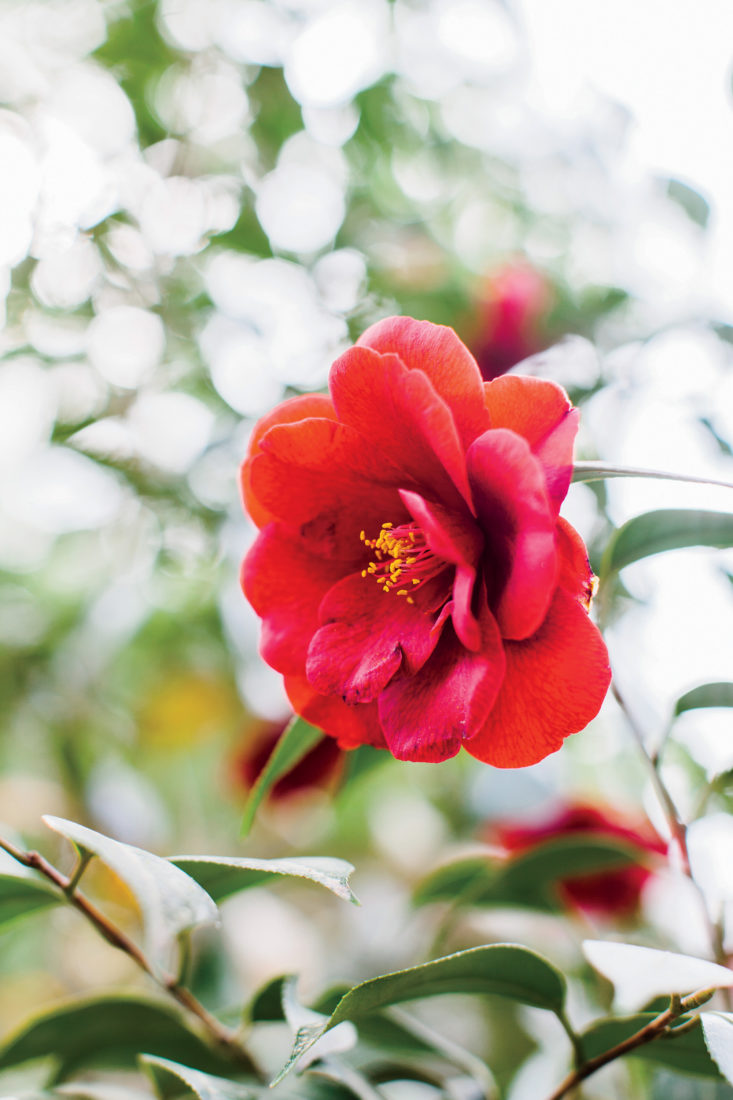
Photo: Ali Harper
A Royal Velvet camellia.
The work keeps his body spry. The stories keep his
mind sharp.
Look here, he says. That’s Prunus mume, the Japanese flowering apricot. He has several, but this one is called Dawn, with pink blossoms that emerge in January. Just about the time those die back, the Edgeworthia chrysantha blooms—that’s a paperbush, with yellow flowers that smell of honey and spice. He has probably told tour groups about these very specimens a hundred times. But even now, he bounces from one to the other in his black Nikes.
“This is what intrigues me about all of it,” he says. “Something happening out here all the time.”
Then he turns, and heads on up the path.



